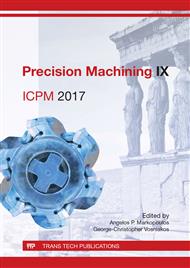[1]
Y. Altintas and M. Weck, Chatter Stability of Metal Cutting and Grinding, CIRP Annals - Manufacturing Technology, vol. 53, no. 2, p.619–642, (2004).
DOI: 10.1016/s0007-8506(07)60032-8
Google Scholar
[2]
G. Quintana and J. Ciurana, Chatter in machining processes: A review, International Journal of Machine Tools and Manufacture, vol. 51, no. 5, p.363–376, (2011).
DOI: 10.1016/j.ijmachtools.2011.01.001
Google Scholar
[3]
D. -T. Nguyen, Potenzial eines Rundschaft-Fräswerkzeugsystems für Forschung und Produktion, Aachen, Shaker, (2009).
Google Scholar
[4]
S. Batt, Ein Beitrag zur Entwicklung von Fräswerkzeugen mit verbesserten dynamischen Schnitteigenschaften, (2009).
Google Scholar
[5]
E. Paucksch, S. Holsten, M. Linß et al., Zerspantechnik: Prozesse, Werkzeuge, Technologien, Vieweg+Teubner Verlag / GWV Fachverlage GmbH, Wiesbaden, Wiesbaden, (2008).
Google Scholar
[6]
H. K. Tönshoff and B. Denkena, Basics of cutting and abrasive processes, Springer, Berlin, New York, (2013).
Google Scholar
[7]
J. Beno, ed., Computation of main cutting force when milling with stepped depth of cut, (2005).
Google Scholar
[8]
B. Karpuschewski and S. Batt, Improvement of Dynamic Properties in Milling by Integrated Stepped Cutting, CIRP Annals - Manufacturing Technology, vol. 56, no. 1, p.85–88, (2007).
DOI: 10.1016/j.cirp.2007.05.001
Google Scholar
[9]
W. Degner, Spanende Formung: Theorie, Berechnung, Richtwerte, Hanser, München [u. a. ], (2002).
DOI: 10.3139/9783446445833.fm
Google Scholar
[10]
F. Klocke and A. Kuchle, Cutting, Springer, Berlin, (2011).
Google Scholar
[11]
J. P. Davim, Machining of hard materials, Springer, London, (2011).
Google Scholar
[12]
Abele, E., et al., Das Hochvorschubfräsen wird neu definiert, ZWF Zeitschrift für wirtschaftlichen Betrieb, Vol 105, Iss. 7/8, p.737–743, (2010).
Google Scholar
[13]
W. Grzesik, Modelling and Simulation of Machining Processes and Operations, in Advanced machining processes of metallic materials: Theory, modelling and applications, W. Grzesik, Ed., p.65–91, Elsevier, Amsterdam, (2017).
DOI: 10.1016/b978-0-444-63711-6.00005-3
Google Scholar
[14]
F. Zanger, N. Boev, and V. Schulze, Novel Approach for 3D Simulation of a Cutting Process with Adaptive Remeshing Technique, Procedia CIRP, vol. 31, p.88–93, (2015).
DOI: 10.1016/j.procir.2015.03.022
Google Scholar
[15]
G. M. Pittalà and M. Monno, 3D finite element modeling of face milling of continuous chip material, The International Journal of Advanced Manufacturing Technology, vol. 47, 5-8, p.543–555, (2010).
DOI: 10.1007/s00170-009-2235-0
Google Scholar
[16]
CIRP., ed., Dictionary of Production Engineering, Springer, Berlin, (2004).
Google Scholar
[17]
R. W. Maruda, G. M. Krolczyk, P. Nieslony et al., The influence of the cooling conditions on the cutting tool wear and the chip formation mechanism, Journal of Manufacturing Processes, vol. 24, p.107–115, (2016).
DOI: 10.1016/j.jmapro.2016.08.006
Google Scholar
[18]
G. T. Smith, Cutting tool technology: Industrial handbook, Springer, London, (2008).
Google Scholar
[19]
J. Beňo, I. Maňková, M. Vrábel et al., Operation Safety and Performance of Milling Cutters with Shank Style Holders of Tool Inserts, Procedia Engineering, vol. 48, p.15–23, (2012).
DOI: 10.1016/j.proeng.2012.09.479
Google Scholar


